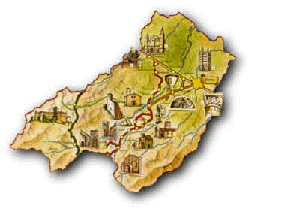


In the mountains, on the hills, in the plains, in every strategic point of the Province of Parma, fortresses and castles (around 100) arose, mainly from the year 200 to the year 500, due to thewishes of the "Rossi's", the "Sanvitale's", the "Pallavicino's", the "Da Correggio's", the "Meli Lupi's" and the "Torelli's". To security they were to add architectual elegance and decorativerichness to the inside, they were strong fortresses, and often the sumptous homes to small and lavish courts, centres of art and culture which during the "Rinascita" era were frequented with enthusiasm by all kinds of poets and painters of the highest fame.
The centuries and the events contributed something but removed a lot: however art, history and legend still exist in the air of these castles, even in those of which only the white ruins showthrough the green shrubbery.The traveller, once having left the Via Emilia, adventures towards the Po, passing by the Benedictine Abbeys; very soon reaches Roncole, where the house of the Maestro lies.
From there, he carries on to Busseto where everything speaks of him and where his fatal musical notes are almost detectable in the air as far as arriving to the villa Saint Agata.
From the 'Parma ducale', where the memories of his travels around the world are preserved, a great stir is caused by Arturo Toscanini who is the greatest interpreter of Verdi in the majortheatres of Europe and America.
The highest of honours have gone to the all time greats: the imminent "Verdiano Festival", is the worthy gift given to Giuseppe Verdi by his country.THE ROMAN ROAD
A day of walking, a stop to rest and setting off again on the medieval pilgrim's itinerary: "homo viator". The Roman Road with the images of the cathedral of Fidenza to the parish churches of Fornovo, Bardone and Berceto, allows you to travel along this path from the plains to the mountains; visiting sculptures in sandstone, of monsters, saints, kings and pilgrims, who aretestimonies of a humanity which is already European.
THE "REGGIA" OF COLORNO AND THE ORANGERIA"
From the dirt track path of the Garden, they left in that late autumn afternoon of more than half a centuary ago, with big vases of oranges , which horses drew as far as the "Orangeria nobile",then inside climbing up a slope which led to the upper level (which today is the site of the ethnografical museum of farming civilisation).
The Duchess had also just left the Palace, which she used as a summer residence, leaving unwillingly that "Versailles dei duchi di Parma", which was considered by her as very "agrčable" forthe appartments of that period, the beautiful lounges, the magnificent English park.THE LOWER PO OF GUARESCHI
It is he, Giovannino who invites us to go into "that fetid fertile land scattered along the banks of the Great River" where "there are people who get worked up easily" and who are stillenthusiastic about "stories that the Great River will tell to who ever goes looking for fairy tales amongst the poplar trees and on the shores". On condition that of course, we go when the heatisn't yet "something that you can see and touch" and the fog isn't such "that you can cut it with a knife".
THE LAKES OF THE APPENINES
In the high northern slopes of the Appenine crests, outlined by green beech trees, sparkling buds shine. The mirrors of water of "Lago Santo", "dei Lagoni" or "Laghi Gemini"in Val Parma, "Lago Ballano in Val Cedra and others more, about twenty altogether,within a small space of mountains, welcome the tourist who loves nature and ancient history,this is the evidence of the dialogue between man and the mountains.
To reveal
the history, the traditions and the flavours of typical products from an
authentic territory where quality is a way of life A PROVINCE OF SPA RESORTS
Once upon a time there was salt in Salsomaggiore.
Then is 1839 Lorenzo
Berzieri, the local authority doctor, discovered the virtues of bathing with "acqua madre".
Maria
Luigia, the Duchess of Parma, granted with generosity the opening of the sulphurous spa resort of Tabiano.
From then onwards everything changed, the salt factories were overtaken bythe spa buildings.
At Salsomaggiore, Queen Margherita was one of the most regular
visitors of the "Grand Hotel des Thermes", whilst the nearby Tabiano recieved Giuseppe Verdi. You can
enter still today into those streams of gold and blue, under the look of the Chimeras and slave statues, in
a perpetual wavy movement, guided by infinite numbers ofcurls and flowers, which repeat themselves in
the "Terme Berzieri, amongst Libertystyle and Art Dčco with inspirations from Ancient Orient.
And the summarized myth of Igea with its procession of servantsThe ancient myth also repeats itself
elsewhere in the province, always at the foot of theAppenines, amongst settings of peaceful tranquillity.
At Monticelli Terme, at S.Andrea Bagni thehealthy waters flow, there you can renew with proved
effectiveness those timeless rituals of the spa cults.